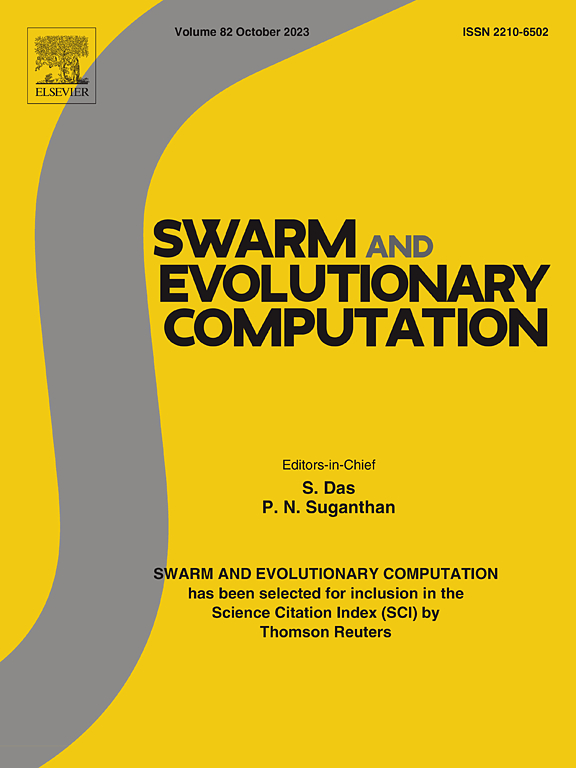Weak-prior medical image matting based on microscale-searching evolutionary optimization
IF 8.5
1区 计算机科学
Q1 COMPUTER SCIENCE, ARTIFICIAL INTELLIGENCE
引用次数: 0
Abstract
Image matting is to predict alpha mattes that reflects the opacity of images, recently showing potential in identifying transition regions of lesions in computer aided diagnosis. Image matting can be modeled as a large-scale combinatorial optimization problem that has numerous subproblems. Evolutionary algorithms (EAs) have been applied to predict accurate alpha mattes. The advantage of EAs-based methods is the ability to predict alpha mattes with weak prior like trimaps that provide value of opacity for pixels effortless to annotate compared to recent deep learning-based methods. However, it is challenging for EAs to solve the problem efficiently due to numerous subproblems and the large size of the decision set. Based on the observation that the similarity of subproblems correlates with the similarity of their objective spaces, this paper proposes a method for estimating a microscale subset of the decision set from the solving process of similar subproblems. A framework is designed to reduce the exploration cost of EAs in the large-scale decision set by guiding EAs to search in this estimated microscale subsets. Three medical image matting datasets are used to validate our method’s improvement in the efficiency of evolutionary algorithms. Experimental results demonstrate that EAs embedded in the proposed framework obtain the best prediction of alpha mattes on medical images and also in weak scenarios involving natural images. Comparative experimental results on multi-objective performance metrics indicate that our method is capable of finding superior solutions using fewer fitness evaluations. The contribution of our work is to make EAs an efficient approach to solving the medical image matting problem with weak prior.
基于微尺度搜索进化优化的弱先验医学图像抠图
图像消光是预测反映图像不透明度的α消光,最近在计算机辅助诊断中显示出识别病变过渡区域的潜力。图像抠图可以被建模为一个具有许多子问题的大规模组合优化问题。进化算法(EAs)已被应用于预测精确的α mattes。与最近基于深度学习的方法相比,基于easa的方法的优点是能够预测具有弱先验的alpha mattes,如trimaps,可以为像素提供不透明度值,无需费力地进行注释。然而,由于子问题众多,决策集规模大,使得ea很难有效地解决问题。基于子问题的相似度与其目标空间的相似度相关的观察,本文提出了一种从相似子问题的求解过程中估计决策集微尺度子集的方法。设计了一个框架,通过引导ea在估计的微尺度子集中搜索,降低ea在大规模决策集中的搜索成本。使用三个医学图像抠图数据集验证了我们的方法在进化算法效率方面的改进。实验结果表明,嵌入在该框架中的ea在医学图像和涉及自然图像的弱场景下都能获得最佳的alpha mattes预测。在多目标性能指标上的对比实验结果表明,我们的方法能够使用更少的适应度评估找到更优的解决方案。本文的工作为解决弱先验的医学图像消光问题提供了一种有效的方法。
本文章由计算机程序翻译,如有差异,请以英文原文为准。
求助全文
约1分钟内获得全文
求助全文
来源期刊

Swarm and Evolutionary Computation
COMPUTER SCIENCE, ARTIFICIAL INTELLIGENCEC-COMPUTER SCIENCE, THEORY & METHODS
CiteScore
16.00
自引率
12.00%
发文量
169
期刊介绍:
Swarm and Evolutionary Computation is a pioneering peer-reviewed journal focused on the latest research and advancements in nature-inspired intelligent computation using swarm and evolutionary algorithms. It covers theoretical, experimental, and practical aspects of these paradigms and their hybrids, promoting interdisciplinary research. The journal prioritizes the publication of high-quality, original articles that push the boundaries of evolutionary computation and swarm intelligence. Additionally, it welcomes survey papers on current topics and novel applications. Topics of interest include but are not limited to: Genetic Algorithms, and Genetic Programming, Evolution Strategies, and Evolutionary Programming, Differential Evolution, Artificial Immune Systems, Particle Swarms, Ant Colony, Bacterial Foraging, Artificial Bees, Fireflies Algorithm, Harmony Search, Artificial Life, Digital Organisms, Estimation of Distribution Algorithms, Stochastic Diffusion Search, Quantum Computing, Nano Computing, Membrane Computing, Human-centric Computing, Hybridization of Algorithms, Memetic Computing, Autonomic Computing, Self-organizing systems, Combinatorial, Discrete, Binary, Constrained, Multi-objective, Multi-modal, Dynamic, and Large-scale Optimization.
 求助内容:
求助内容: 应助结果提醒方式:
应助结果提醒方式:


